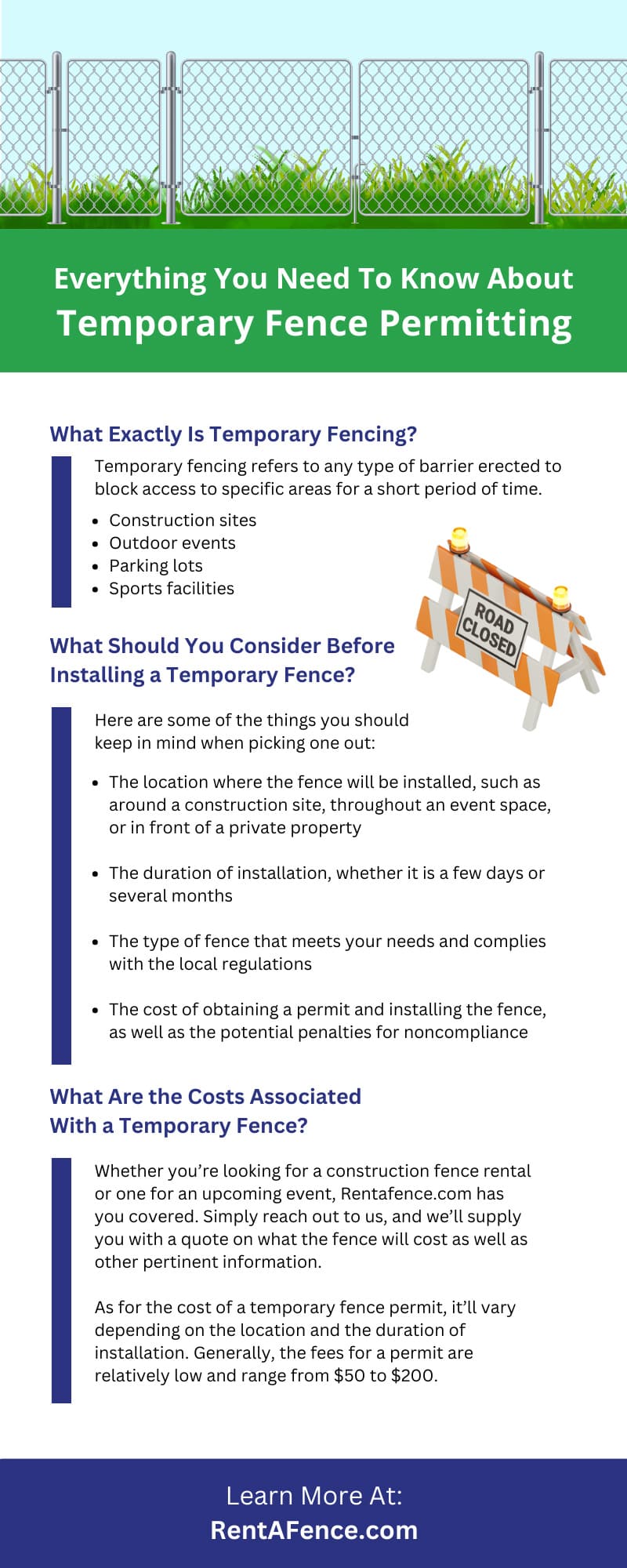In this post, we’ll discuss everything you need to know about temporary fence permitting, from the definition of temporary fencing to the permit application process, and provide tips and resources to help you comply with the regulations and ensure a safe and successful project or event.
What Exactly Is Temporary Fencing?
Temporary fencing refers to any type of barrier erected to block access to specific areas for a short period of time. Depending on the purpose, temporary fencing can be made of different materials, such as wood, metal, plastic, or even fabric. They have various designs as well, such as chain-link, welded wire, or metal bars. Some common uses of temporary fencing include:
- Construction sites: to prevent unauthorized entry or falling objects, and comply with OSHA regulations
- Outdoor events: to guide the flow of attendees, secure vendors, or separate VIP areas
- Parking lots: to restrict access or designate reserved spaces
- Sports facilities: to define the playing area or protect the audience from the game
What Should You Consider Before Installing a Temporary Fence?
Now that you know the reasons for this type of fencing, you’ll need to decide which one best suits your specific needs. However, that’s not the only thing you should consider before installing a temporary fence. Here are some of the things you should keep in mind when picking one out:
- The location where the fence will be installed, such as around a construction site, throughout an event space, or in front of a private property
- The duration of installation, whether it is a few days or several months
- The type of fence that meets your needs and complies with the local regulations
- The cost of obtaining a permit and installing the fence, as well as the potential penalties for noncompliance
What Are the Costs Associated With a Temporary Fence?
The cost of a temporary fence is typically the biggest concern for those who’ve never used one before. Whether you’re looking for a construction fence rental or one for an upcoming event, Rentafence.com has you covered. Simply reach out to us, and we’ll supply you with a quote on what the fence will cost as well as other pertinent information.
As for the cost of a temporary fence permit, it’ll vary depending on the location and the duration of installation. Generally, the fees for a permit are relatively low and range from $50 to $200. If you fail to obtain a permit and install a temporary fence anyway, you might face penalties or fines, which can be much higher than the cost of the permit.
Why Do You Need a Temporary Fence Permit?
Now that you know the consequences of not getting a permit, it’s important to understand the reasons behind why you need one. Typically, the purpose of the permit is to ensure that the fence complies with the local codes and standards, is safe and stable, and does not create any obstacles or hazards for the public or other properties.
Sometimes, specific temporary fence setups will be exempt from the need for a permit. If that’s the case, it’s important to note that you’ll still need to comply with other laws and regulations that govern the use and placement of temporary fences, so be sure to look into those as well.
How To Apply for a Temporary Fence Permit
While we’ve covered a lot so far, the most important thing to know about temporary fence permits is how to apply for one. The process can seem daunting to first-timers, but it’ll be more straightforward if you follow the detailed steps we’ve listed below.
Research the Local Regulations
The first step is to research the local regulations about temporary fence permitting. You should check the website of your local authority, such as the building department, public works, or the events office, to find out the requirements, exact fees, and forms for applying for a permit. You can also call or email the authority to ask any questions or clarifications.
Prepare the Permit Application
Once you have all the local regulation details, it’ll be time to prepare the permit application. While these vary depending on your area, they typically include the following key points:
- Completing the permit application form with accurate and detailed information about your project or event, such as the location, dates, and hours of operation
- Submitting the site plan, which shows the location, and size of the fence, any access, or egress points, and any other relevant details, such as the distance from the property line, or the sidewalk
- Submitting the fence specifications, which include the type of fence, the height, the anchorage, the wind load, and any other relevant details that ensure the fence is safe and stable
- Providing the insurance and liability coverage, which may include general liability, workers’ compensation, and property damage insurance, depending on the jurisdiction and the type of project or event
Submit the Application and Pay the Fee
After filling out all the important info, it’ll be time for you to submit the completed application to your local authority. Along with the application, this is when you’ll need to pay the required permit application fee. When it comes to submitting the application, you should have multiple options available to you. These include submitting it to your local authority in person, through the mail, or even online. Simply pick the one available that works best for your needs.
Approval and Installation
The approval process can vary greatly depending on how efficient or backlogged your local authority is. It’s usually a good idea to ask ahead of time how long the approval process might take. However, the best practice is simply to submit your application as soon as possible. That way, you won’t have to worry about any complications or delays.
Once the relevant authorities have approved the permit, you can then proceed with the installation of the temporary fence. It is crucial to prioritize safety by adhering to all applicable safety regulations and codes specific to your location. Failing to do so could lead to your permit becoming void, leading to the previously mentioned penalties. By doing everything correctly, you can ensure a secure and compliant installation that meets the necessary standards and guidelines.


Recent Comments